This article will focus on helping you to decide if ADSL broadband, Ethernet First Mile (EFM), Fibre to the Cabinet (FTTC), Ethernet over FTCC, FTTP or Fibre are best for your business. Too many acronyms already? Stick with us we'll help you get there!
What is DSL?
If your business is on a budget, the chances are you are using or are considering using DSL. DSL is an entry-level basic business broadband solution which uses a phone line to transmit data.
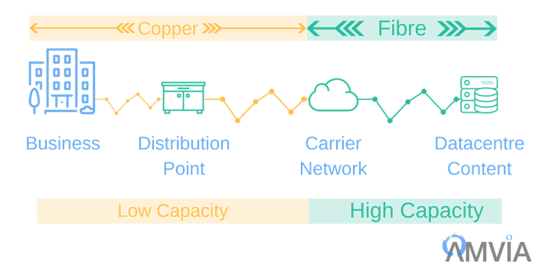
What are the advantages of DSL?
The main advantage is pricing, which varies according to connection speed, so you may have chosen to secure a low price because you don’t require breakneck performance or you can afford outages. DSL is a low-cost budget option. Business DSL is priced on a fixed monthly fee. The charges range from £10-25/month depending on the speed and contention in your contract.
What are the disadvantages of DSL?
Lower prices do come with certain disadvantages. If your business is rural or far away from your provider’s point of presence, you will experience slower speeds. Also, when phone lines go down this will mean a loss of internet service, which is often detrimental to your business.
Business broadband packages do offer dedicated business customer support. If you lose connectivity, you will be able to contact a representative 24/7 so that you can immediately raise a support ticket for help with your problems. There are service level agreements with DSL but these are known as best endeavors, and in reality, the service provider has as long as they choose to reinstate your service, while you have to be patient and wait. This weak aspect of DSL is essential to consider when downtime translates into the loss of company revenue; this is often the determining factor in the selection of fibre over DSL.
So the disadvantages of DSL are mainly tied back to cost. While broadband does offer competitive speeds that may be more than enough for some businesses to operate efficiently, faster, more reliable options, such as fibre, may be more expensive but may provide a better return on investment.
What is FTTC?
FTTC or "Fibre To The Cabinet" is an alternative to business broadband. Instead of using copper lines to carry data, FTTC uses fibre for part of the fixed line service. Fibre is a faster and more reliable technology than the copper used throughout a DSL service. FTTC uses fibre to connect the local Openreach point of presence (PoP) to the nearest BT exchange. The "last mile" from the Openreach PoP to your premises is copper. Although copper is far more inefficient at transferring data, the distance between the cabinet and the end-user premises is usually shorter than the distance between your premises and the local exchange. The speed that FTTC can attain is often far higher than traditional DSL.
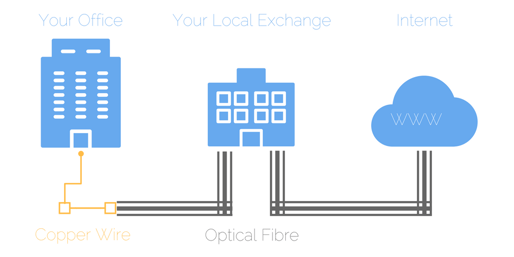
What are the advantages of FTTC?
If you are using an ADSL broadband line, upgrading to FTTC is quick and easy. A simple broadband checker will give you an indicative speed. If you want to upgrade then the process is simple. An order is placed on your existing line, and usually, within ten working days, your service is enhanced. FTTC offers speeds of up to 80Mbps download and upload speeds of up to 20Mbps. The cost of FTTC is usually about £75-£100/month.
Some points to be careful of when considering FTTC:
FTTC is not widely available. It is a new technology that is being introduced throughout the UK. Each BT exchange in the UK has to be upgraded for FTTC.
Contention – FTTC can offer very high theoretical speeds. The contention or line sharing is the most significant factor that could affect the bandwidth rate you see through an FTTC service. Line sharing could mean that at busy times there may be a noticeable drop in FTTC bandwidth performance due to the number of other businesses using the service. FTTC like DSL has a "best endeavors" SLA (Service Level Agreement). This means that there are no uptime guarantees or guaranteed service restoration times in the event of an outage. At Amvia we use FTTC primarily as an additional backup/failover connection for a fibre line.
EFM is another option.
EFM or Ethernet First Mile is an advanced DSL solution based on copper lines. Copper lines are bonded to create a business grade service that can be supported by an SLA. It is the only copper leased line alternative. EFM works by bonding copper pairs making it more resilient than ADSL – if copper one pair fails the others remain live meaning that uptime SLAs are possible. Usually, the SLA comes in the form of a 6-hour fix. Some carriers also guarantee service restoration times in the event of an outage.
What are the advantages of EFM?
EFM is a symmetrical bandwidth product. Upload and download bandwidth speeds are the same. By having symmetrical bandwidth businesses to benefit from higher rates of upload than standard DSL with the assurance of an SLA. There are usually shared EFM services available with 5:1 contention, as well as dedicated 1:1 contention services for businesses who do not want to share bandwidth. Uncontended EFM means your business can always rely on fast upload/download access speeds, making the service ideal for Hosted VoIP, Hosted Exchange or Cloud SAAS services which can demand high upload speeds.
EFM is a business broadband service so you should expect to receive a robust SLA (Service Level Agreement). The SLA should offer an uptime guarantee as well as fix time commitments in the event of an outage. Strong SLAs are essential for any businesses who rely critically on their data connection.
Considerations around EFM
EFM is more expensive than FTTC because the bandwidth is symmetrical. The bandwidth is also more resilient and guaranteed with an SLA. EFM may, therefore, be too expensive for smaller SME businesses. Often it is an excellent fit for a 5-10 person business running VoIP and an online CRM system like Salesforce.com.
Another consideration is the delivery time – EFM technology requires the installation of new copper lines, then EFM specific hardware is connected. When considering delivery timescales, EFM takes on average over 45 working days to deliver. EFM may not be the right choice if you need delivery in 45 days or less.
Pricing and availability are further EFM considerations. EFM prices are fixed based on the bandwidth ordered. Prices range from £125/month to £225/month. EFM is not yet available throughout the UK, to find out if connecting EFM to your business is possible you can use an EFM checker.
What about EoFTTC?
You could also consider EoFTTC (also known as GEA). GEA is a hybrid FTTC/EFM product. GEA has been designed to make the transition from broadband into the world of Ethernet less painful from a cost perspective. GEA uses a combination of EFM and FTTC infrastructure to deliver a business grade service with an SLA.
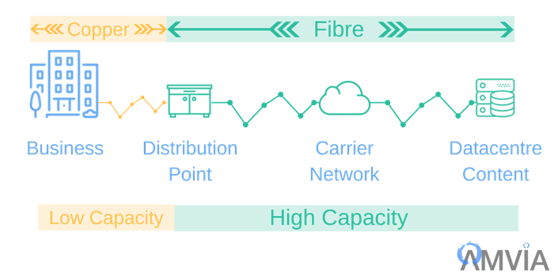
What about Fibre?
Fibre is a dedicated fibre optical link to your office. Speeds are scalable to more than 10Gb, that's 2000 broadband lines! You can select the bandwidth that you need over the fibre service such as 50Mbps on a 100Mbps line. You often have the option to upgrade the speed at short notice.
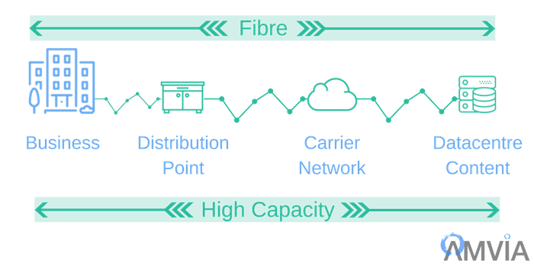
While there is no question that fibre is the future of internet connectivity, this technology is still only available in a limited number of areas. While businesses in many cities can access fibre many suburban and rural locations are still not served. You will want to find out which providers offer fibre as an option at your site, or how you can work with nearby off-net providers who could connect your company to their fibre network in the future.
If fibre connections aren't already installed in your area, you may be able to pay a fee to connect your office to a fibre network. Connecting your premises involves digging up the ground and laying fibre optical cable between your location and the core network of the provider. This option has significant upfront costs known as excess construction charges (ECC). For some companies, this may be a significant investment that you aren’t prepared to make, but it is important to remember that the primary costs associated with fibre occur during the installation process. Once you purchase a fibre connection and have it installed, you will begin experiencing a return on your investment.
Fibre contracts come with service level agreements (SLAs) that guarantee your problem will be resolved within a specified period or your provider will be responsible for financially compensating you for the losses you experienced. This type of insurance can provide peace of mind and a financial security net during times of crisis. It's important to note though that the compensation you will receive is directly related to the service charge. The payment is not associated with any consequential losses your Company may incur.
Fibre also offers increased levels of security, which are vital to protecting sensitive information from your customers and your business. When you work with a fibre provider, you are buying a private dedicated link which is far more secure than a shared service.
Which service is right for you?
If cost is no object, then buy fibre. It's dedicated, fast, reliable, secure and future-proof.
GEA and EFM are for businesses with a modest budget who require a combination of robust reliability and upload/download speed. If your company needs a business grade service and you use VoIP, and hosted applications, GEA and EFM are a good fit.
If FTTC is available, it can serve as the ideal solution for SME’s who need a rapid way to improve existing ADSL bandwidth speeds. It delivers higher speed at a lower cost with a short installation time.
DSL is the last resort option when either budget or availability constraints mean your choices are limited.
.png?width=200&height=75&name=Amvia%20New%20Header%20Logo%20(11).png)
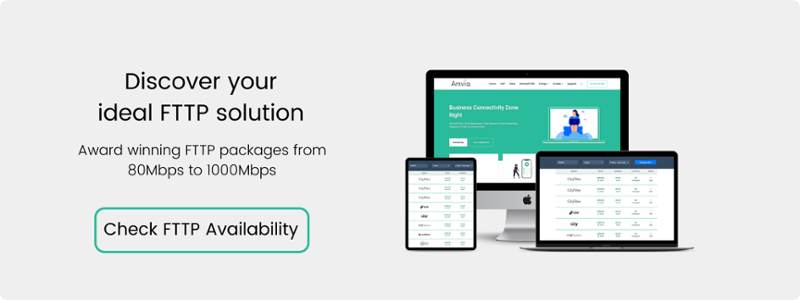


.png)